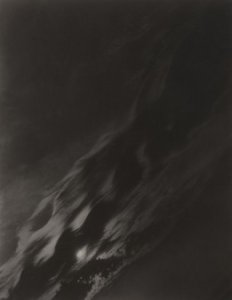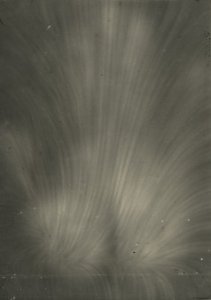Photo Corners headlinesarchivemikepasini.com
![]()
A S C R A P B O O K O F S O L U T I O N S F O R T H E P H O T O G R A P H E R
![]()
Reviews of photography products that enhance the enjoyment of taking pictures. Published frequently but irregularly.
Fraenkel Gallery Hangs 'The Unphotographable'


4 January 2013
On a beautiful Friday afternoon with a mountain of work to avoid, we snuck out of the bunker and hopped on a bus then a streetcar to take in "an ambitious survey exploring the history of that which cannot be photographed."
Which is just the ticket when you've seen it all.
Wandering through the three-room exhibit at the Fraenkel Gallery, we caught a glimpse of what you can't ever see.
Two of the 50 images were stunts. You can probably guess what they were. No? OK, one was a completely black print. Want to guess the other now? Right. A completely white one. Ha ha, as Joseph Heller once put it.
Between those two extremes, well, there were more extremes.
LOCH NESS
Take, for example, the 1934 snapshot attributed to Robert Kenneth Wilson of the Loch Ness Monster. Certainly the monster cannot be photographed. And yet -- abracadabra -- there it is, raising its diminutive noggin at the top of its slender neck like Dino the Dinosaur above the sparkling surface of the loch.

Steiglitz: Equivalent
This particular print had the far shoreline cropped out. Apparently Wilson himself didn't take the photo. He merely claimed to have taken it. The hoax was revealed in 1994 when one of the protagonists confessed on his death bed.
But now that we've finally seen the famous photo of the monster that doesn't exist, we can die happy.
THE PARANORMAL
That was across the room from the proofs of the paranormal. Delightful stuff that sunk to levels so low your average school boy would be embarrassed.
Seriously. One "apparition" was clearly nothing more than a finger over the lens.
More amusing in the same collection was an Arthur Conan Doyle photo which proudly insisted it had been achieved with a single exposure. It was required to make that claim because the one silhouette and two sharp figures in the image all overlaid one another just like a multiple exposure. So to have any claims of paranormal authenticity, the obvious technique had to be denied.
Would Arthur Conan Doyle lie to us? But wait a second. This is the same guy who penned The Case for Spirit Photography in 1923 to defend Billy Hope, a medium who had been taken such photos for 17 years.
Doyle actually developed and fixed plates Hope had exposed to confirm they were not manipulated, insisting they were not touched before exposure, nor substituted after, nor double exposed, nor composited, nor retouched.
Doyle took his own spirit snapshots, like the one in the show.
So how did he do it? Our guess is a slow shutter (Bulb) would do it. With three subjects sitting quite still for a bit to register their images on the film . The shutter stays open so, technically, it isn't a double exposure. Just a long one. With spirited if not paranormal subjects.
THE SUPERNATURAL
There's a small photo by Alfred Stieglitz in the exhibit that lent some higher purpose in our visit. We found it and peered at it intently trying to make it out.
There was a partially obscured bright disc sinking in the lower part of the image, surrounded by streamers of what looked like storm clouds. He wasn't beyond taking photos of clouds and this looked like one he'd extended the shutter speed to make whisps of the clouds passing by the celestial body.
A small placard nearby, however, boasted that some people felt that he had captured God in that shot, which he called Equivalent. Perhaps he simply misunderstood the exclamation, "My God!"
AN ARBUS
Kitty corner from the Stieglitz was a black and white by Diane Arbus. It's been making the rounds of the 9/11 memorial shows apparently, even though it's from an earlier era. The 1950s, in fact.
We were particularly taken by it.
It shows a New York City intersection at night with a newspaper blowing across it. We know the feeling.
To her credit, she doesn't claim it's an image of the Holy Spirit, though it does bear a striking resemblance to Fiorello H. La Guardia.
But if you linger in front of it a bit, you soon realize it won't be long before the paperboys are out in the morning darkness to deliver the next edition. And not long after that before the print edition is discontinued. Nor long before the news, however we get it, becomes so old and brittle that not even memory can keep it from blowing away.
MAN RAY
There's a Man Ray, too. A nude male reclining on his solarized shadow a bit like this one. The shadow just sort of fades away into light, a nice effect, if a bit paranormal.
THE BODY
A few of the images are scientific curiosities, the kind you might have paid a quarter to see at the Fun House. Carl Wernicke's 1897 Psychiatric Clinic in Wroclaw. Atlas of the Brain. First Division, Frontal Section is like that. But there were others.

Majewski
On the other hand, you might have paid a good deal more and not at the Fun House to see Jakob Ottonowitsch von Narkiewitsch-Jodko's 1895 image of A Spark Captured on the Surface of the Body of a Well-Washed Prostitute. We looked at it a long time without finding the spark.
We found one you might try at home sometime, too. Adrien Majewski photographed his right hand in a 20 minute exposure he titled Mr. Majewski's Right Hand Posed for 20 Minutes. That's something you can't see without a photograph.
MORE
Among the other noteworthy images are Malcolm Browne's Self-Immolation of Buddhist Monk Thich Quang Duc taken in Saigon in 1963. You see the seated monk surrounded by flames that, captured at a high shutter speed, tail toward the right without blurring.
What's unphotographable about it, you might wonder. It's a political statement so the taboo of photographing a suicide doesn't quite apply. But it is an extraordinary spectacle all the same. And something, really, you wish you hadn't seen.
THE EXHIBIT, THE SHOW, THE BOOK
We won't drag you through a description of all 50 images. For that there's the show itself if you find yourself in San Francisco, the slide show at the gallery Web site or the book.
The exhibit runs through March 23 at the Fraenkel Gallery, 49 Geary St. in San Francisco (fourth floor). The Unphotographable: Works in photographic media.
The catalog is also available if you prefer to stay home (details below).
Great fun, though, however you see these clever images which, of course, can't actually ever really be seen.
The Unphotographable, edited by Jeffrey Fraenkel, published by Fraenkel Gallery, 120 pages, $55 (or $34.65 at amazon.com).